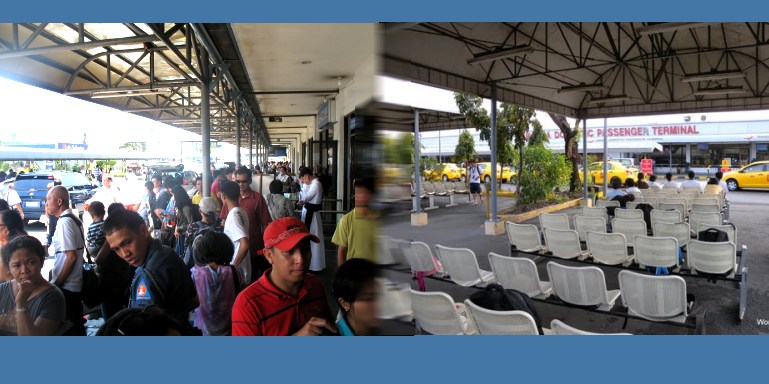Manila Airport Arrival Guide
You have landed in Manila, we show you how to continue
MIAA, the Manila International Airport Authority, plans to re-assign most airlines to other terminals. Originally scheduled for August 2018, the work has stalled. Be careful, this complete change of terminals can now happen any time. Please check with your airline BEFORE flying!
Lots of people complain about Manila Airport (MNL). Sorry, but we cannot understand them. Maybe, they have never been lost in London's Heathrow (LHR) or misguided in Paris' Charles de Gaulle (CDG) during a strike.
In the last few years all terminals have been overhauled and look now rather fine. There are still some Filipino particularities. Consider them as folklore.
Lots of people complain about Manila Airport (MNL). Sorry, but we cannot understand them. Maybe, they have never been lost in London's Heathrow (LHR) or misguided in Paris' Charles de Gaulle (CDG) during a strike.
In the last few years all terminals have been overhauled and look now rather fine. There are still some Filipino particularities. Consider them as folklore.
Follow our guided and illustrated tour and enjoy your arrival at Manila NAIA airport by clicking above on the corresponding terminal where you arrive.
Although the procedures are the same for all 4 terminals, there are some important differences especially if somebody is waiting for you.
For connecting flights see our Transfer Guide and our Departure Guide.
If you are looking for a particular facility in one of the 4 terminal, then have a look in our NAIA Airport Maps.
These maps show all terminals and the whole Manila Airport.
Arrival in NAIA-1
[International flights only]
Manila NAIA-1 is the principal terminal for international flights. It is exclusively reserved for international flights and has no domestic section. It is the oldest building at Manila airport but had recently been partially refurbished.
The first feeling is warm and humid air when you leave the plane. Please be aware that Manila is never colder than 24°C (75°F) and that it can get as hot as 36°C (97°F). Humidity is usually around 60% but can hike up to 100%. Inside the terminals air is sometimes hot as hell or cold as in a freezer. We recommend to have a light vest ready in you hand-carry luggage.
You will need between 20 and 60 minutes before you leave this terminal on the other side. This time depends on the number of incoming planes at this moment but also on your luggage and maybe your visa requirements.
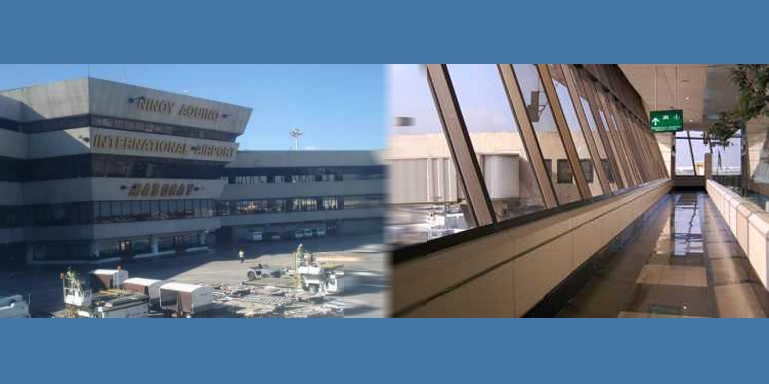
Health monitoring
Walk through the windowed alleys and follow the signs to the luggage pick-up zone. Do not run. Your luggage needs more time than you do to get to the belt. The alleys are seldom as empty. But when 3 heavy carriers arrive within 15 minutes, the walk can quickly turn in a stop and go.
A few meters later you will have to pass the health control. Since WHO has issued Bird Flue and SARS alerts, the Philippines authorities control your body temperature on arrival. The control stations are situated at the end of the two "Y" branches of NAIA-1 international terminal.
If you just caught a cold the day before leaving your cold country, we recommend to take one or two Aspirins or Paracetamols 2 hours before landing in Manila NAIA.
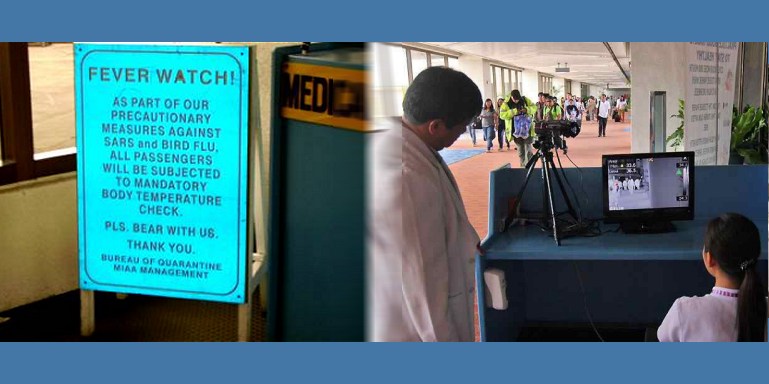
Transfer Desk
It is a good idea to check here if you have your passport, your disembarkation card, your customs declaration form and the ticket with the luggage tags on hand. These 4 items will be requested during your journey through Manila Arrival.
Transit passengers find information at the "Airline Passenger Transfer Desk". This desk is only useful for international transfers. The transfer to domestic destinations is handled outside the International Terminal.
If you have a question or a problem of any kind, do not hesitate to ask the cheerful staff at the information desk. This desk is situated just before the immigration counters.
Please check also our Manila Transfer Guide.
On your way to immigration you also pass by an "arrival duty-free shop" and an information desk.

Immigration
The first obstacle will be the lines to the immigration counters. Since 2010 this section of the airport is being re-organized permanently. The problem is to handle as many passengers as possible with the staff on duty. At this very moment (summer 2016) you queue up in a single s-shape queue and are dispatched to next available counter.
Arriving Filipinos no longer have to fill out the new immigration arrival cards while foreigners, including Philippine passport holders with existing immigrant status, will be required to fill out the new arrival cards.
As a tourist you need to be able to show the immigration officers that your passport is valid for at least another six months. You also have to hand over your duly filled-in arrival card. This arrival card you got during your flight. If you have lost it, there are desks at the walls with piles of them. Often you have to show also an onward international flight ticket that allows you to leave the country. If you comply, then you will be automatically allowed entry for up to 30 days without a visa. This is called a tourist visa-waver. It can be extended to 59 days directly at the airport.
Hint: Check the "valid until" date when you already have a 59 days visa-waver. Sometimes the immigration officer insert automatically 30 days.
Have a look at our Visa Information for further details.
New 11/2015
From November 2015 you may also encounter the new e-counters. These new machines will read your biometric passport, scan your fingerprints and shoot a photo of you. The procedure will take 30-60 seconds. Then you can process through a special counter. You will not need to fill in the arrival card. For more information please read here.
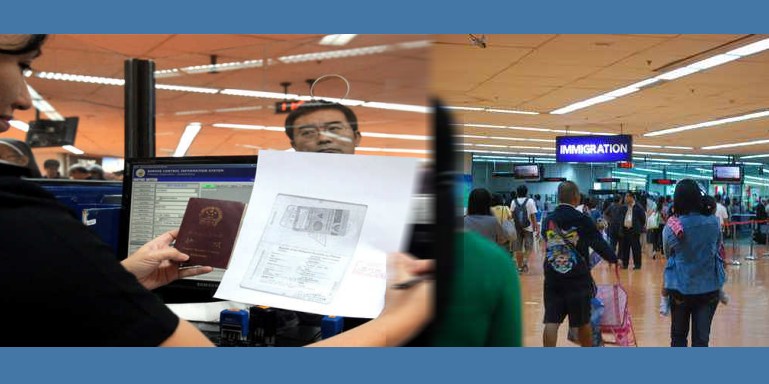

Luggage claim
In the luggage pick-up area a number of conveyor belts will bring you your luggage. Above each conveyor belt is a flight information board letting you know which conveyor belt your luggage will arrive at. There are free trolleys available and here you find the Interline Baggage Room (phone: +63 2 877-1109 local 3633).
Your patience may be tested in this area. Sometimes it takes an awful long time until your luggage arrives. Count about 30 minutes and sometimes much more...
Next step will be the customs desks. You will have to present your Customs Declaration Form. Just now you have enough time to fill it in.
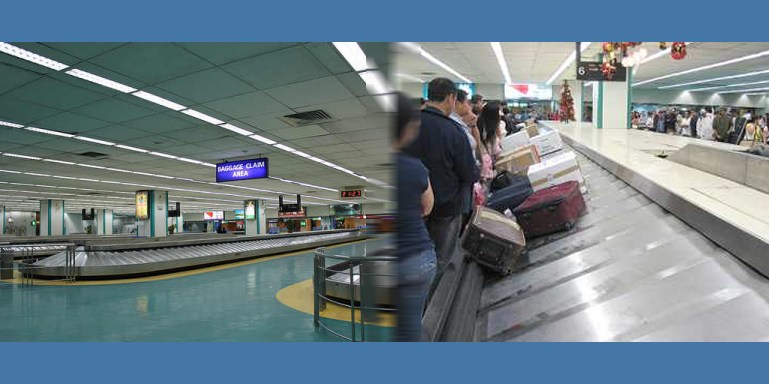
Customs
The Philippines customs are a bit different than in other countries. There is no real "green channel" without customs officers. You have to pass by a desk.
There are different desks: "Nothing to declare", "Goods to declare", "OFWs" and more. Depending on the content on your form and in your luggage choose one of the first two channels.
If you have something to declare - do it. If you do not and the customs officer finds something, then your goods will be seized and you will be fined.
The customs officer will stamp and sign your declaration form. This form you have to hand over to an other officer before leaving the customs area.

Arrival Lobby
Before you reach the Arrival Lobby there is a last check, the Luggage Tag Check Point. Have your ticket with the tag ready. If the tags on your ticket correspond to the tags on your luggage you pass.
In the Arrival Lobby you should change some of your currency in Philippine Pesos (PHP). The exchange rates are not too bad. There are also ATMs available.
Outside you may get a hotel taxi or bus, a yellow airport-taxi or the transfer shuttle for the 3 other terminals. For the later, consult our Transfer section.
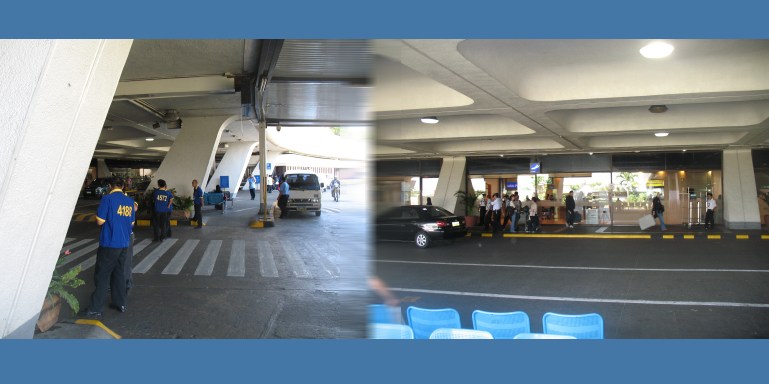
Local transportation
If you are on low budget or if you are very familiar with Manila's taxis and their drivers, then you may go up to the departure section and catch a white taxi. Be careful, it might be much more expensive than the yellow airport taxi. It also might be dirty and hot. You have been warned.
The yellow airport taxis are the safest way to get to your destination!
See also our taxi section.
The shuttle bus waits at the far right end of the building.
See also our Manila Transfer Guide.
And if you are a real hard core backpacker then you might wish to ride on a Jeepney (PUJ). The jeepneys wait outside of the "Greeters area" (see below). They drive to many points in Metro Manila. The most interesting ones might be the bus terminals on EDSA. You will have to ask the drivers or other passengers. If this is your first stay in Manila, we absolutely do not recommend this kind of transportation.
See also our jeepney section.

Somebody is waiting
The only possibility in NAIA-1 to wait for some arriving person is the "greeters area". This is a construction outside of the airport opposing the arrival lobby
There are about 20 waiting zones. Each one of them is marked with a letter from A to Z. These letters can be identified from both sides - the welcome party's side and the arrival side. Please agree in a letter in advance. Most commonly used is the first letter of your family name.
Your welcome party can drive into the parking lot behind the greeters are and wait for you in the agreed zone.
When you arrive at NAIA-1, then you leave the airport building, cross over the road and go down the stairs. You will see a semi circular construction with big letter signs. Your party will welcome you under the agreed letter.

Arrival in NAIA-2
NAIA-2 or the "Centennial" Terminal is exclusively used by Philippine Airlines (PAL) and some few code-sharing partners.
NAIA-2 has two wings: The north wing handles the international flights and from the south wing operate PAL's domestic flights. Between the two wings is a circular connection, where you find PAL's ticket counters and customer service.
The first feeling is warm and humid air when you leave the plane. Please be aware that Manila is never colder than 24°C (75°F) and that it can get as hot as 36°C (97°F). Humidity is usually around 60% but can hike up to 100%. Inside the terminal it might sometimes be hot as hell or cold as in a freezer. We recommend to have a light vest ready in you hand-carry luggage.
You will need between 15 and 40 minutes before you leave this terminal on the other side. This time depends on your luggage and maybe your visa requirements.
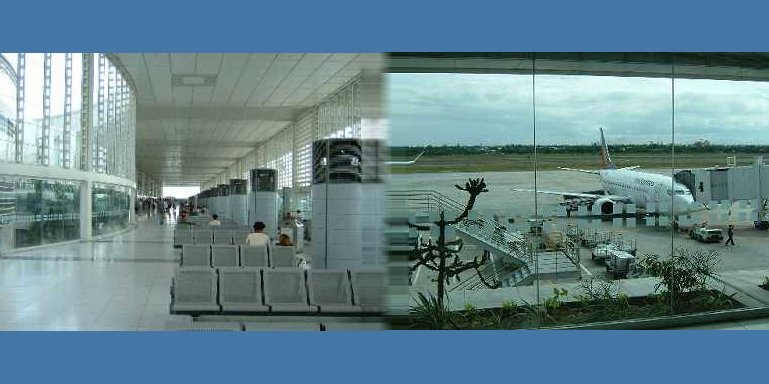
Health monitoring
[Applies only to the international arrivals]
Walk through rather modern building and follow the signs to the luggage pick-up zone. Do not run. Your luggage needs more time than you do to get to the belt. NAIA-2 is much less stress than NAIA-1, where often 3 heavy carriers arrive within 10 minutes. Feel happy to be here!
Anywhere between your aircraft and immigration you will pass the health control. Since WHO has issued Bird Flue and SARS alerts, the Philippines authorities control your body temperature on arrival. In NAIA-2 they mostly use handheld devices.
If you just caught a cold the day before leaving your cold country, we recommend to take one or two Aspirins or Paracetamols two hours before landing in Manila NAIA. You won't be a bright red spot on the monitor.
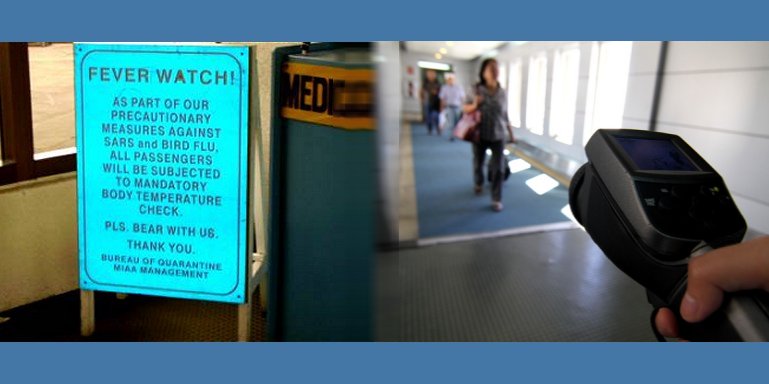
Immigration
The first obstacle will be the lines to the immigration counters. Since 2010 this section of the airport is being re-organized permanently. The problem is to handle as many passengers as possible with the staff on duty. At this very moment (summer 2016) you queue up in a single s-shape queue and are dispatched to next available counter.
Arriving Filipinos no longer have to fill out the new immigration arrival cards while foreigners, including Philippine passport holders with existing immigrant status, will be required to fill out the new arrival cards.
As a tourist you need to be able to show the immigration officers that your passport is valid for at least another six months. You also have to hand over your duly filled-in arrival card. This arrival card you got during your flight. If you have lost it, there are desks at the walls with piles of them. Often you have to show also an onward international flight ticket that allows you to leave the country. If you comply, then you will be automatically allowed entry for up to 30 days without a visa. This is called a tourist visa-waver. It can be extended to 59 days directly at the airport.
Hint: Check the "valid until" date when you already have a 59 days visa-waver. Sometimes the immigration officer insert automatically 30 days.
Have a look at our Visa Information for further details.
New 11/2015
From November 2015 you may also encounter the new e-counters. These new machines will read your biometric passport, scan your fingerprints and shoot a photo of you. The procedure will take 30-60 seconds. Then you can process through a special counter. You will not need to fill in the arrival card. For more information please read here.


Transfer Desk
There seems to be a transfer assistance desk by PAL. We have never seen this service in NAIA-2.
PAL write on their website:
Between Centennial Terminal 2 and Terminal 3
Passengers transferring via Manila with confirmed connecting flight on Philippine Airlines and PAL Express shall be provided with free air-side shuttle service to and from Centennial Terminal 2 and Terminal 3.
The passengers coming from International/Regional flights at Terminal 2 will clear with Immigration, Customs and will claim their baggage at the carousel. The passenger is requested to proceed to the transfer desk for issuance of transit cards and transfer to Terminal 3.
Please check also our Manila Transfer Guide.
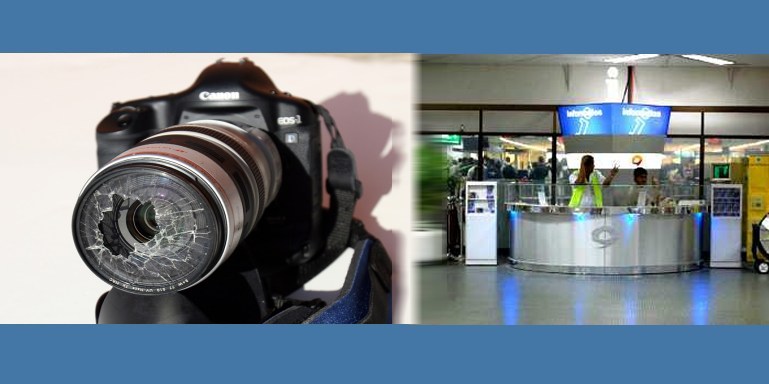
Luggage claim
In the luggage pick-up area a number of conveyor belts will bring you your luggage. Above each conveyor belt is a flight information board letting you know which conveyor belt your luggage will arrive at. There are free trolleys available and here you find the Interline Baggage Room (phone: +63 2 877-1109 local 3633).
Your patience may be tested in this area. Sometimes it takes an awful long time until your luggage arrives. Count about 30 minutes and sometimes much more...
Next step will be the customs desks. You will have to present your Customs Declaration Form. now you have enough time to prepare it.

Customs
[Applies only to the international arrivals]
The Philippines customs are a bit different than in other countries. There is no real "green channel" without customs officers. You have to pass by a desk.
There are different desks: "Nothing to declare", "Goods to declare", "OFWs" and more. Depending on the content on your form and in your luggage choose one of the first two channels.
If you have something to declare - do it. If you do not and the customs officer finds something, then your goods will be seized and you will be fined.
The customs officer will stamp and sign your declaration form. This form you have to hand over to an other officer before leaving the customs area.

Arrival Lobby
[Applies to both arrivals]
Before you reach the Arrival Lobby there is a last check, the Luggage Tag Check Point. Have your ticket with the tag ready. If the tags on your ticket correspond to the tags on your luggage you pass.
[Applies only to the international arrivals]
In the Arrival Lobby you should change some of your currency in Philippine Pesos (PHP). The exchange rates are not too bad. There are also ATMs available.
[Applies to both arrivals]
Outside you may get a hotel taxi or bus, a yellow airport-taxi or the transfer shuttle for the 3 other terminals. For the later, consult our Transfer section.

Local transportation
If you are on low budget or if you are very familiar with Manila's taxis and their drivers, then you may catch a white taxi. Be careful, it might be much more expensive than the yellow airport taxi. It also might be dirty and hot. You have been warned.
The yellow airport taxis are the safest way to get to your destination!
See also our taxi section.
The shuttle bus waits just out of the international arrival. If you don't see it, ask an agent.
See also our Manila Transfer Guide.
And if you are a real hard core backpacker then you might wish to ride on a Jeepney (PUJ). The jeepneys wait outside of the terminal fence. They drive to many points in Metro Manila. The most interesting ones might be the bus terminals on EDSA. You will have to ask the drivers or other passengers. If this is your first stay in Manila, we absolutely do not recommend this kind of transportation.
See also our jeepney section.

Somebody is waiting
Waiting for somebody in NAIA-2 is easy and simple.
There is a parking lot in the center space of the terminal. Greeters can wait just outside the respective terminal doors (international and domestic wings) and are protected from sun and rain.
What a pleasure compared with NAIA-1.
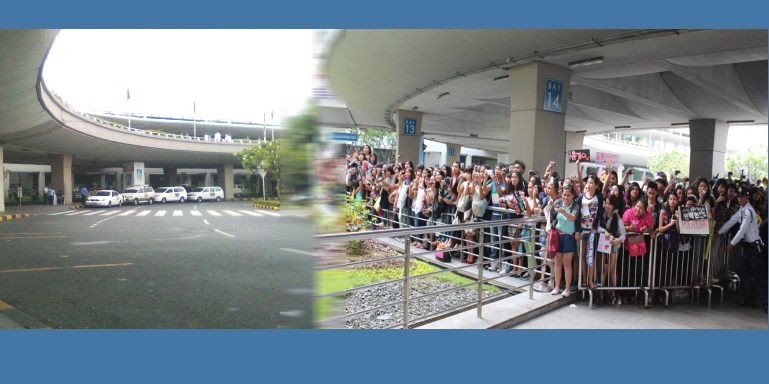
Arrival in NAIA-3
NAIA-3 is the newest of the 4 terminals in Manila's airport.
NAIA-3 has both, international and domestic sections. They are very similar and are only separated by glass walls.
The terminal's construction is not yet finished. About 20% of the building are not yet operational.
If you are lucky, your plane stops at a finger dock and you can walk directly to the terminal building. But most of the time you have to climb down to the tarmac. There an antique airport bus from Korea waits for you and shakes you the entrance gate. Inside the terminal it might sometimes be hot as hell or cold as in a freezer. We recommend to have a light vest ready in you hand-carry luggage.
You will need between 15 and 50 minutes before you leave this terminal on the other side. This time depends on your luggage and maybe your visa requirements.

Health monitoring
[Applies only to the international arrivals]
Walk through rather modern building and follow the signs to immigration. Do not run. Your luggage needs more time than you do to get to the belt.
Anywhere between your aircraft and immigration you will pass the health control. Since WHO has issued Bird Flue and SARS alerts, the Philippines authorities control your body temperature on arrival. In NAIA-3 they mostly use handheld devices.
If you just caught a cold the day before leaving your cold country, we recommend to take one or two Aspirins or Paracetamols two hours before landing in Manila NAIA. You won't be a bright red spot on the monitor.

Immigration
[Applies only to the international arrivals]
As a tourist you need to be able to show the immigration officers that your passport is valid for at least another six months.
Arriving Filipinos no longer have to fill out the new immigration arrival cards while foreigners, including Philippine passport holders with existing immigrant status, will be required to fill out the new arrival cards.
You also have to hand over your duly filled-in arrival card. This arrival card you got during your flight. If you have lost it, there are desks at the walls with piles of them. Often you have to show also an onward international flight ticket that allows you to leave the country. If you comply, then you will be automatically allowed entry for up to 30 days without a visa. This is called a tourist visa-waver. It can be extended to 59 days directly at the airport.
Hint: Check the "valid until" date when you already have a 59 days visa-waver. Sometimes the immigration officer insert automatically 30 days.
Have a look at our Visa Information for further details.
New 11/2015
From November 2015 you may also encounter the new e-counters. These new machines will read your biometric passport, scan your fingerprints and shoot a photo of you. The procedure will take 30-60 seconds. Then you can process through a special counter. You will not need to fill in the arrival card. For more information please read here.


Luggage claim
To get your luggage or head out directly, you have to descend one level. In the luggage pick-up area a number of conveyor belts will bring you your luggage. Aside each conveyor belt is a sign, indicating the airline. There is only one carousel per airline.
Your patience may be tested in this area. Sometimes it takes an awful long time until your luggage arrives. Count about 10 to 30 minutes and sometimes much more...
Next step will be the customs desks. You will have to present your Customs Declaration Form.
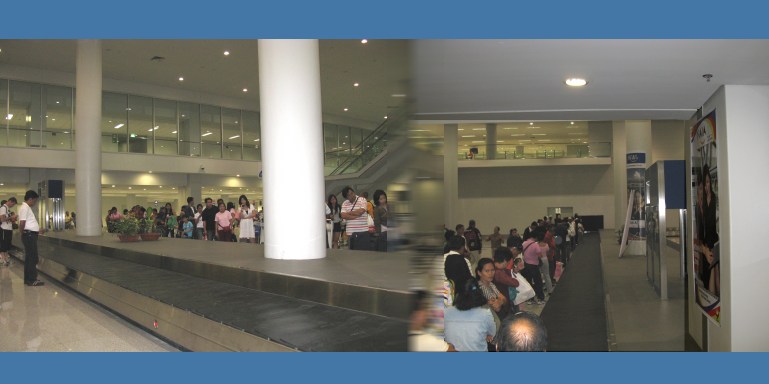
Transfer Desk
There are transfer assistance desks in both sections.
PAL write on their website:
Between Centennial Terminal 2 and Terminal 3
Passengers transferring via Manila with confirmed connecting flight on Philippine Airlines and PAL Express shall be provided with free air-side shuttle service to and from Centennial Terminal 2 and Terminal 3.
The passengers coming from International/Regional flights at Terminal 3 will clear with Immigration, Customs and will claim their baggage at the carousel. The passenger is requested to proceed to the transfer desk for issuance of transit cards and transfer to Terminal 2.
Please check also our Manila Airport Transfer Guide.
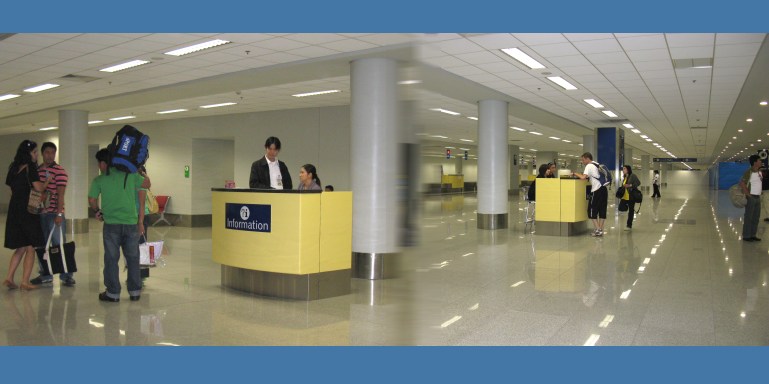
Customs
[Applies only to the international arrivals]
The Philippines customs are a bit different than in other countries. There is no real "green channel" without customs officers. You have to pass by a desk.
There are different desks: "Nothing to declare", "Goods to declare", "OFWs" and more. Depending on the content on your form and in your luggage choose one of the first two channels.
If you have something to declare - do it. If you do not and the customs officer finds something, then your goods will be seized and you will be fined.
The customs officer will stamp and sign your declaration form. This form you have to hand over to an other officer before leaving the customs area.

Arrival Lobby
Before you reach the Arrival Lobby there is a last check, the Luggage Tag Check Point. Have your ticket with the tag ready. If the tags on your ticket correspond to the tags on your luggage you pass.
In the Arrival Lobby you can change some of your currency in Philippine Pesos (PHP). The exchange rates are not too bad. There are also ATMs available.
NAIA-3s Arrival Lobby meets international standards. It is clean and spacious and you find enough signs that help you to find your way. Only missing thing is a newsstand with international newspapers and a welcome bar.
Outside you may get a hotel taxi or bus, a yellow airport-taxi or the transfer shuttle for the 3 other terminals. For the later, consult our Transfer section.

Local transportation
If you are on low budget or if you are very familiar with Manila's taxis and their drivers, then you may go up to the departure section and catch a white taxi. Be careful, it might be much more expensive than the yellow airport taxi. It also might be dirty and hot. You have been warned.
See also our taxi section.
And if you are a real hard core backpacker then you might wish to ride one Jeepney (PUJ). The jeepneys wait outside of the terminal fence near the pink church. They drive to many points in Metro Manila. The most interesting ones might be the bus terminals on EDSA. You will have to ask the drivers or other passengers. If this is your first stay in Manila, we absolutely do not recommend this kind of transportation.
See also our jeepney section.
The yellow airport taxis are the safest way to get to your destination!
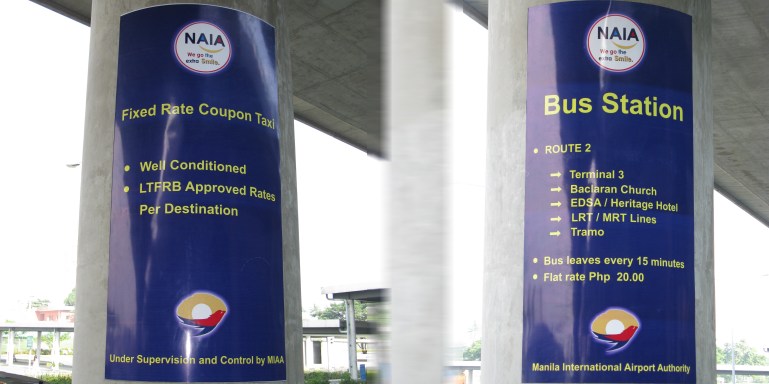
Somebody is waiting
Waiting for somebody in NAIA-3 is easy.
There is a parking lot opposite of the terminal. Greeters can wait just outside the doors or can now go inside and wait behind a glass front.
What a pleasure compared with NAIA-1.

Arrival in NAIA-4
NAIA-4 has again been transformed. Since end of September 2015 all small planes from Cebu Pacific Air and Philippine Airlines are operating from this terminal. Read our blog for immediate updates.
The NAIA-4 terminal or the New - "Old Domestic Terminal" had been completely overhauled and looks rather nice. But it isn't comfortable at all.
From the aircraft you walk over the tarmac to a small entrance door marked arrival. When it rains or when the sun is burning down you sometimes get an umbrella.
Please be aware that Manila is never colder than 24°C (75°F) and that it can get as hot as 36°C (97°F). Humidity is usually around 60 to 80% but can hike up to 100%. Inside the terminal it might sometimes be hot as hell.
You will need between 5 and 15 minutes before you leave this terminal on the other side. This time depends on your luggage and the speed of the unloading crew.
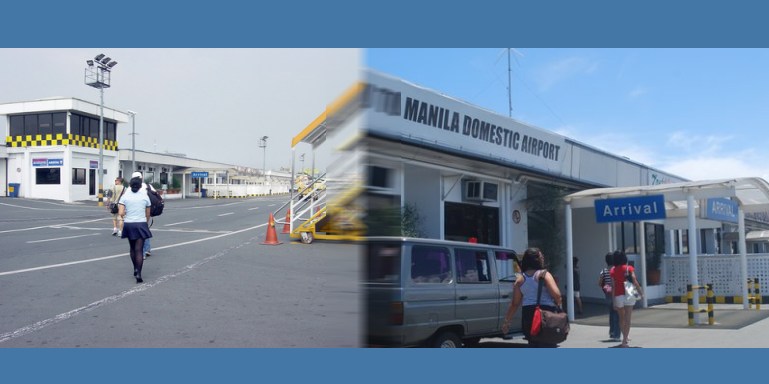
Baggage claim
In the luggage pick-up area 4 new conveyor belts will bring your luggage inside. You can see the arriving of the luggage transporters.
Luggage is usually available within 5 minutes. If you flew with one of the last A320 here, then it might take 15 minutes.
With or without luggage you simply walk out. There is no lobby or anything else. You are out in the street.

Local transportation
If you are on low budget or if you are very familiar with Manila's taxis and their drivers, then you may catch a white taxi. Be careful, it might be much more expensive than the yellow airport taxi. It also might be dirty and hot. You have been warned.
See also our taxi section.
And if you are a real hard core backpacker then you might wish to ride on a Jeepney (PUJ). The jeepneys wait outside on the road side. They drive to many points in Metro Manila. The most interesting ones might be the bus terminals on EDSA. You will have to ask the drivers or other passengers. If this is your first stay in Manila, we absolutely do not recommend this kind of transportation.
See also our jeepney section.
The yellow airport taxis are the safest way to get to your destination!

Somebody is waiting
Waiting for somebody in NAIA-4 is easy and simple.
There is a covered seating area opposite the main entrance and there is plenty of space under the roof just out of the arrival section.
You may also want to wait in one of the restaurants just around the corner. The walk there lasts less than 2 minutes.
